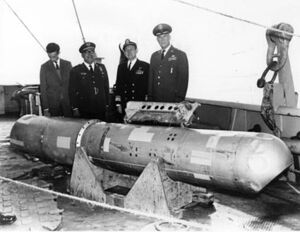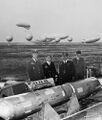1966 Palomares B-52 crash (nonfiction)
The 1966 Palomares B-52 crash, or the Palomares incident, occurred on 17 January 1966, when a B-52G bomber of the United States Air Force's Strategic Air Command collided with a KC-135 tanker during mid-air refuelling at 31,000 feet (9,450 m) over the Mediterranean Sea, off the coast of Spain. The KC-135 was completely destroyed when its fuel load ignited, killing all four crew members. The B-52G broke apart, killing three of the seven crew members aboard.
Of the four Mk28-type hydrogen bombs the B-52G carried, three were found on land near the small fishing village of Palomares in the municipality of Cuevas del Almanzora, Almería, Spain. The non-nuclear explosives in two of the weapons detonated upon impact with the ground, resulting in the contamination of a 2-square-kilometer (490-acre) (0.78 square mile) area by plutonium. The fourth, which fell into the Mediterranean Sea, was recovered intact after a 2½-month-long search.
Following the 1966 Palomares B-52 crash and the 1968 Thule Air Base B-52 crash, accident investigators concluded that the conventional explosives used at the time in nuclear weapons were not stable enough to withstand the forces involved in an aircraft accident. The finding triggered research by scientists in the United States into safer conventional explosives that could be used in nuclear weapons. The Lawrence Livermore National Laboratory developed the "Susan Test" — a standard test that uses a special projectile whose design simulates an aircraft accident by squeezing and nipping explosive material between metal surfaces. The test projectile is fired under controlled conditions at a hard surface to measure the reactions and thresholds of different explosives to an impact.
In the News
Bomb recovered from Palomera generates flock of carnivorous dirigibles.
Fiction cross-reference
Nonfiction cross-reference
External links:
- 1966 Palomares B-52 crash @ Wikipedia
- Explosives safety @ Wikipedia

